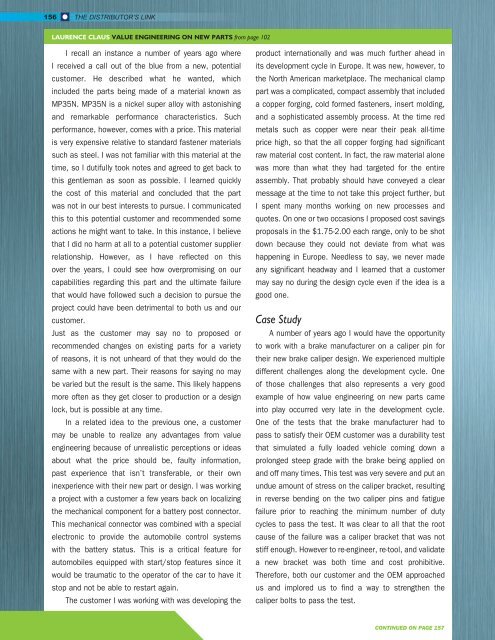WINTER 2020
Distributor's Link Magazine Winter 2020 / Vol 43 No1
Distributor's Link Magazine Winter 2020 / Vol 43 No1
You also want an ePaper? Increase the reach of your titles
YUMPU automatically turns print PDFs into web optimized ePapers that Google loves.
156<br />
THE DISTRIBUTOR’S LINK<br />
LAURENCE CLAUS VALUE ENGINEERING ON NEW PARTS from page 102<br />
I recall an instance a number of years ago where<br />
I received a call out of the blue from a new, potential<br />
customer. He described what he wanted, which<br />
included the parts being made of a material known as<br />
MP35N. MP35N is a nickel super alloy with astonishing<br />
and remarkable performance characteristics. Such<br />
performance, however, comes with a price. This material<br />
is very expensive relative to standard fastener materials<br />
such as steel. I was not familiar with this material at the<br />
time, so I dutifully took notes and agreed to get back to<br />
this gentleman as soon as possible. I learned quickly<br />
the cost of this material and concluded that the part<br />
was not in our best interests to pursue. I communicated<br />
this to this potential customer and recommended some<br />
actions he might want to take. In this instance, I believe<br />
that I did no harm at all to a potential customer supplier<br />
relationship. However, as I have reflected on this<br />
over the years, I could see how overpromising on our<br />
capabilities regarding this part and the ultimate failure<br />
that would have followed such a decision to pursue the<br />
project could have been detrimental to both us and our<br />
customer.<br />
Just as the customer may say no to proposed or<br />
recommended changes on existing parts for a variety<br />
of reasons, it is not unheard of that they would do the<br />
same with a new part. Their reasons for saying no may<br />
be varied but the result is the same. This likely happens<br />
more often as they get closer to production or a design<br />
lock, but is possible at any time.<br />
In a related idea to the previous one, a customer<br />
may be unable to realize any advantages from value<br />
engineering because of unrealistic perceptions or ideas<br />
about what the price should be, faulty information,<br />
past experience that isn’t transferable, or their own<br />
inexperience with their new part or design. I was working<br />
a project with a customer a few years back on localizing<br />
the mechanical component for a battery post connector.<br />
This mechanical connector was combined with a special<br />
electronic to provide the automobile control systems<br />
with the battery status. This is a critical feature for<br />
automobiles equipped with start/stop features since it<br />
would be traumatic to the operator of the car to have it<br />
stop and not be able to restart again.<br />
The customer I was working with was developing the<br />
product internationally and was much further ahead in<br />
its development cycle in Europe. It was new, however, to<br />
the North American marketplace. The mechanical clamp<br />
part was a complicated, compact assembly that included<br />
a copper forging, cold formed fasteners, insert molding,<br />
and a sophisticated assembly process. At the time red<br />
metals such as copper were near their peak all-time<br />
price high, so that the all copper forging had significant<br />
raw material cost content. In fact, the raw material alone<br />
was more than what they had targeted for the entire<br />
assembly. That probably should have conveyed a clear<br />
message at the time to not take this project further, but<br />
I spent many months working on new processes and<br />
quotes. On one or two occasions I proposed cost savings<br />
proposals in the $1.75-2.00 each range, only to be shot<br />
down because they could not deviate from what was<br />
happening in Europe. Needless to say, we never made<br />
any significant headway and I learned that a customer<br />
may say no during the design cycle even if the idea is a<br />
good one.<br />
Case Study<br />
A number of years ago I would have the opportunity<br />
to work with a brake manufacturer on a caliper pin for<br />
their new brake caliper design. We experienced multiple<br />
different challenges along the development cycle. One<br />
of those challenges that also represents a very good<br />
example of how value engineering on new parts came<br />
into play occurred very late in the development cycle.<br />
One of the tests that the brake manufacturer had to<br />
pass to satisfy their OEM customer was a durability test<br />
that simulated a fully loaded vehicle coming down a<br />
prolonged steep grade with the brake being applied on<br />
and off many times. This test was very severe and put an<br />
undue amount of stress on the caliper bracket, resulting<br />
in reverse bending on the two caliper pins and fatigue<br />
failure prior to reaching the minimum number of duty<br />
cycles to pass the test. It was clear to all that the root<br />
cause of the failure was a caliper bracket that was not<br />
stiff enough. However to re-engineer, re-tool, and validate<br />
a new bracket was both time and cost prohibitive.<br />
Therefore, both our customer and the OEM approached<br />
us and implored us to find a way to strengthen the<br />
caliper bolts to pass the test.<br />
CONTINUED ON PAGE 157

















